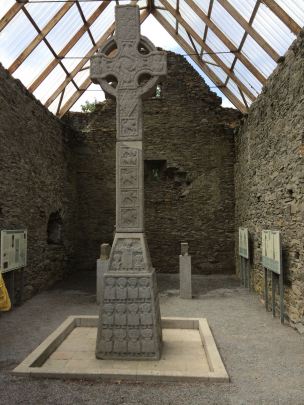Camino Society Outing – Kilkea Castle, Castledermott, Moone, Ballitore
After a long hot summer, the weather in the early hours of the morning and on the journey out of Dublin was anything but promising with the windscreen wipers active right up to Kilkea Castle and Golf Course, where we had a break for coffee.
From there on, things looked up and the intermittent showers only fell on the coach as we travelled from venue to venue, stopping most considerately each time we were due to get out of the bus.
Our first stop was at St James’s Church, Castledermott, a small Church of Ireland church, where our guides, Ken and Rowan Stanley, gave us a most informative and amusing tour of both the church and graveyard, introducing us to a ‘swearing’ stone, a hog stone and two Celtic crosses. Most memorable inside the building was the beautiful stained glass window depicting the sower and his seed.
Travelling north to Moone, we walked the short distance, in sunshine, to the High Cross, where John Parkin provided us with an equally informative and amusing explanation as to the significance of Celtic crosses in general and of this one in particular, part of which featured on the publicity for RTE’s Radharc programme many years ago. It is so well preserved that several of us wondered if it was indeed the original it is!
After a brief stop for lunch, we headed to Ballitore, a seventeenth-century Quaker village, where the group divided in two to visit in turn the Quaker meeting house and the library. Olivia Ashmore, on the way to the meeting house, explained to us how the Quakers arrived in the area, the origin of the village and school and listed a number of well known Quaker families, the Shackeltons, Bewleys, Odlums, Fullers, and Jacobs. Only a handful of families remain today in the area but they continue to meet regularly on a Sunday in Ballitore.
In the library, Mario gave us a most interesting account of the life and times of Mary Leadbetter, daughter of the Quaker school principal, who was not allowed herself to attend the prestigious boys’ school founded by the Quakers. She was however educated at home and it is thanks to her ‘Annals of Ballitore’ that we are able to piece together the social and political history of the seventeenth century in that part of rural Ireland, as viewed from her window in the heart of the village.
A spontaneous gesture by Mary Ashmore, wife of Don, a local farmer, brought us to their beautiful farmhouse for refreshments before we headed to the Green Barn restaurant at Burtown House for a delicious evening meal.
We thank all our guides and Mary and Don for making it such a special day.
Betty, Eric, and Lesley





